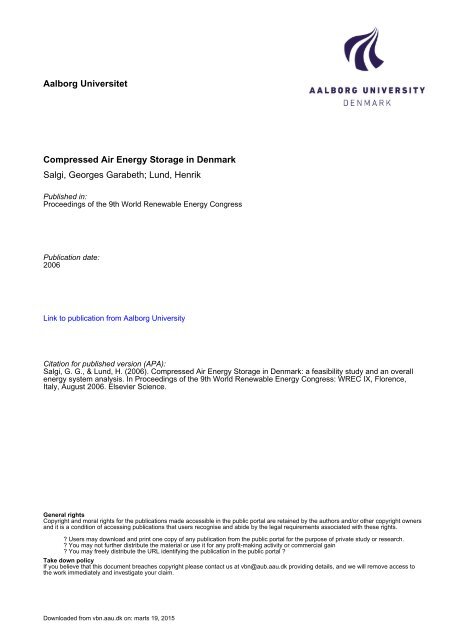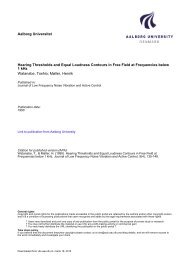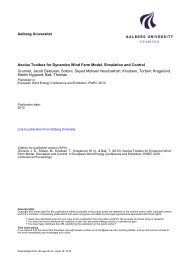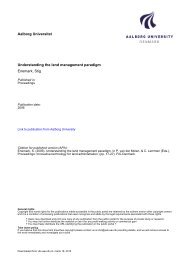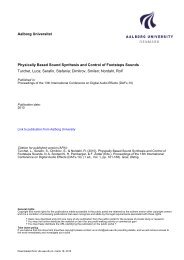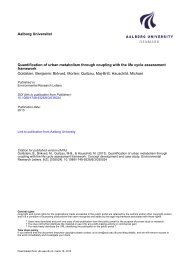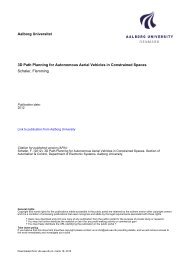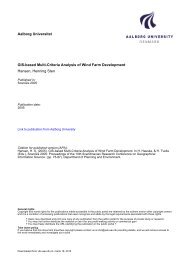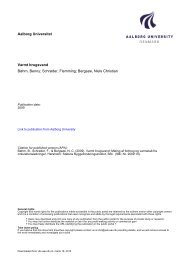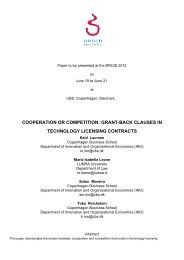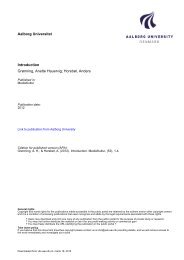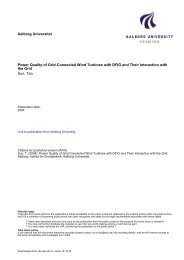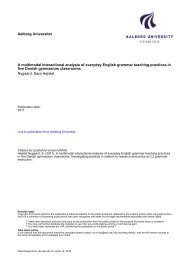Compressed Air Energy Storage in Denmark - VBN
Compressed Air Energy Storage in Denmark - VBN
Compressed Air Energy Storage in Denmark - VBN
You also want an ePaper? Increase the reach of your titles
YUMPU automatically turns print PDFs into web optimized ePapers that Google loves.
Aalborg Universitet<br />
<strong>Compressed</strong> <strong>Air</strong> <strong>Energy</strong> <strong>Storage</strong> <strong>in</strong> <strong>Denmark</strong><br />
Salgi, Georges Garabeth; Lund, Henrik<br />
Published <strong>in</strong>:<br />
Proceed<strong>in</strong>gs of the 9th World Renewable <strong>Energy</strong> Congress<br />
Publication date:<br />
2006<br />
L<strong>in</strong>k to publication from Aalborg University<br />
Citation for published version (APA):<br />
Salgi, G. G., & Lund, H. (2006). <strong>Compressed</strong> <strong>Air</strong> <strong>Energy</strong> <strong>Storage</strong> <strong>in</strong> <strong>Denmark</strong>: a feasibility study and an overall<br />
energy system analysis. In Proceed<strong>in</strong>gs of the 9th World Renewable <strong>Energy</strong> Congress: WREC IX, Florence,<br />
Italy, August 2006. Elsevier Science.<br />
General rights<br />
Copyright and moral rights for the publications made accessible <strong>in</strong> the public portal are reta<strong>in</strong>ed by the authors and/or other copyright owners<br />
and it is a condition of access<strong>in</strong>g publications that users recognise and abide by the legal requirements associated with these rights.<br />
? Users may download and pr<strong>in</strong>t one copy of any publication from the public portal for the purpose of private study or research.<br />
? You may not further distribute the material or use it for any profit-mak<strong>in</strong>g activity or commercial ga<strong>in</strong><br />
? You may freely distribute the URL identify<strong>in</strong>g the publication <strong>in</strong> the public portal ?<br />
Take down policy<br />
If you believe that this document breaches copyright please contact us at vbn@aub.aau.dk provid<strong>in</strong>g details, and we will remove access to<br />
the work immediately and <strong>in</strong>vestigate your claim.<br />
Downloaded from vbn.aau.dk on: marts 19, 2015
<strong>Compressed</strong> air energy storage <strong>in</strong> <strong>Denmark</strong>; a feasibility study and<br />
an overall energy system analysis<br />
Georges Salgi * and Henrik Lund<br />
Department of Development and Plann<strong>in</strong>g, Aalborg University,<br />
Fibigerstraede 13, 9220 Aalborg, <strong>Denmark</strong><br />
Abstract<br />
<strong>Compressed</strong> air energy storage system (CAES) is a technology which can be used for<br />
<strong>in</strong>tegrat<strong>in</strong>g more fluctuat<strong>in</strong>g renewable energy sources <strong>in</strong>to the electricity supply<br />
system. On a utility scale, CAES has a high feasibility potential compared to other<br />
storage technologies. Here, the technology is analysed with regard to the Danish<br />
energy system. In <strong>Denmark</strong>, w<strong>in</strong>d power supplies 20% of the electricity demand and<br />
50% is produced by comb<strong>in</strong>ed heat and power (CHP). The operation of CAES<br />
requires high electricity price volatility. However, <strong>in</strong> the Nordic region, large hydro<br />
capacities have so far kept the prices from fluctuat<strong>in</strong>g to the extent that CAES<br />
<strong>in</strong>vestments have not been considered feasible. This report studies the effect of<br />
technological development and possible future price development of <strong>in</strong>vestments <strong>in</strong><br />
CAES plants of various capacities. It is found that advanced high-efficiency CAES<br />
plants are likely to become feasible <strong>in</strong> the near future.<br />
Keywords: <strong>Compressed</strong> air energy storage, electricity market, regulat<strong>in</strong>g power<br />
1. Introduction<br />
In 2004, w<strong>in</strong>d energy provided 32% of<br />
the electricity consumption <strong>in</strong> Western<br />
<strong>Denmark</strong>. The current total <strong>in</strong>stalled<br />
w<strong>in</strong>d turb<strong>in</strong>e capacity is 2400 MW, of<br />
which 213 MW is offshore. This<br />
compares to an electricity consumption<br />
that varies between 1,150MW and<br />
3,800MW. With high w<strong>in</strong>d velocities,<br />
w<strong>in</strong>d power production can exceed the<br />
local electricity demand. Moreover, the<br />
chang<strong>in</strong>g w<strong>in</strong>d velocity gives rise to a<br />
large need of fast reserve capacity to<br />
regulate the power imbalances. The<br />
ability of the electricity system to<br />
accommodate this high level of w<strong>in</strong>d<br />
energy is further complicated by the<br />
high percentage of decentralized smallscale<br />
CHP power plants with a total<br />
capacity of 1593 MW.<br />
The system operator <strong>in</strong> Western<br />
<strong>Denmark</strong> (Energ<strong>in</strong>et.dk) has so far<br />
been able to deal with these challenges<br />
by us<strong>in</strong>g both local thermal resources<br />
and connections to neighbour<strong>in</strong>g<br />
electricity systems. Follow<strong>in</strong>g a new<br />
legislation, major CHP plants<br />
exceed<strong>in</strong>g 5 MW are gradually<br />
operat<strong>in</strong>g on market conditions. As an<br />
<strong>in</strong>itial result, this operation has shown<br />
an improved system balance. Such<br />
CHP plants used to operate <strong>in</strong><br />
accordance with a triple tariff system<br />
which was not <strong>in</strong>fluenced by system<br />
unbalances com<strong>in</strong>g from e.g. w<strong>in</strong>d<br />
power [1]. However, as neighbour<strong>in</strong>g<br />
countries have plans to <strong>in</strong>crease their<br />
w<strong>in</strong>d production <strong>in</strong> the future, this<br />
could reduce the regulat<strong>in</strong>g capacities<br />
available from abroad. From the<br />
perspective of socio-economy and<br />
security of supply, local reserves are<br />
preferred, especially s<strong>in</strong>ce excess w<strong>in</strong>d<br />
power is sold at low prices and bought<br />
aga<strong>in</strong> later at higher prices.<br />
- 1 -
To solve the problem on a long term<br />
with even more w<strong>in</strong>d power <strong>in</strong> the<br />
system, one will have to comb<strong>in</strong>e a<br />
variety of different technologies [2-6].<br />
Electricity storage is one of the<br />
possible solutions to the challenges<br />
mentioned above. However, very few<br />
technologies tend to be economical on<br />
a utility scale. At a local level <strong>in</strong><br />
<strong>Denmark</strong>, one of the potentially<br />
feasible technologies available<br />
nowadays is compressed air energy<br />
storage (CAES).<br />
<strong>Compressed</strong> air energy storage<br />
(CAES) is a modification of the basic<br />
gas turb<strong>in</strong>e (GT) technology, <strong>in</strong> which<br />
low cost electricity is used for stor<strong>in</strong>g<br />
compressed air <strong>in</strong> an underground<br />
cavern. This air is then heated and<br />
expanded <strong>in</strong> a gas turb<strong>in</strong>e to produce<br />
electricity dur<strong>in</strong>g peak demand hours.<br />
As it derives from GT technology,<br />
CAES technology is readily available<br />
and reliable. Two plants have been<br />
constructed <strong>in</strong> the world so far; one <strong>in</strong><br />
Germany and one the USA of 390 MW<br />
and 110 MW turb<strong>in</strong>e capacities,<br />
respectively.<br />
Recent feasibility studies have shown<br />
that a CAES plant <strong>in</strong>vestment <strong>in</strong><br />
<strong>Denmark</strong> is economically unfeasible<br />
with the current electricity prices [7].<br />
This is ma<strong>in</strong>ly due to the connection<br />
with the hydro-dom<strong>in</strong>ated Nordic<br />
region which reduces price volatility.<br />
However, future system analyses show<br />
an expected <strong>in</strong>crease <strong>in</strong> both average<br />
electricity prices and price volatility, <strong>in</strong><br />
particular after year 2012 <strong>in</strong> the case<br />
that no <strong>in</strong>vestments <strong>in</strong> new power<br />
plants are made. This <strong>in</strong>crease arises<br />
from a comb<strong>in</strong>ation of projected<br />
<strong>in</strong>crease <strong>in</strong> electricity demand and a<br />
rise <strong>in</strong> CO 2 quota prices [8]. On the<br />
basis of these future price analyses, the<br />
feasibility of three CAES technological<br />
scenarios is studied <strong>in</strong> this paper from<br />
a bus<strong>in</strong>ess- economic perspective.<br />
2. CAES Plant Modell<strong>in</strong>g<br />
A mathematical model was developed<br />
for simulat<strong>in</strong>g the behaviour of a<br />
CAES plant on the electricity market.<br />
The model is divided <strong>in</strong>to two parts:<br />
technical model and operational model.<br />
Technical Model<br />
The technical model follows an objectoriented<br />
approach. A thermodynamic<br />
model is constructed for the ma<strong>in</strong><br />
CAES plant components (compressors,<br />
<strong>in</strong>ter and after coolers, throttl<strong>in</strong>g<br />
valves, storage cavern, combustion<br />
chambers, turb<strong>in</strong>es, a regenerator, and<br />
a motor/generator unit).<br />
A generic CAES plant design is then<br />
constructed on the basis of data from<br />
the CAES plant <strong>in</strong> Alabama [9]. The<br />
plant consists of a four-stage<br />
compression and a two-stage<br />
expansion <strong>in</strong>clud<strong>in</strong>g a regenerator<br />
(figure 1). The components are<br />
cascaded <strong>in</strong> the model where the<br />
output of one unit is used as the <strong>in</strong>put<br />
to another.<br />
Figure 1: Generic CAES plant design used <strong>in</strong><br />
the mathematical model.<br />
The behaviour of the <strong>in</strong>dividual<br />
compressor and turb<strong>in</strong>e units was<br />
described us<strong>in</strong>g isentropic efficiencies.<br />
The storage was assumed to be airtight<br />
with constant wall temperature at<br />
35˚C [10].<br />
- 2 -
Three ma<strong>in</strong> performance <strong>in</strong>dicators<br />
were used to describe the efficiency of<br />
the plant:<br />
- The electricity ratio (El.Ratio),<br />
def<strong>in</strong>ed as the amount of electrical<br />
power <strong>in</strong>put per electricity unit<br />
output.<br />
- The Fuel Ratio def<strong>in</strong>ed as the heat<br />
value of the utilized fuel per<br />
electricity unit output.<br />
- The Heat Ratio def<strong>in</strong>ed as the<br />
wasted heat <strong>in</strong> the compression and<br />
expansion process per electricity<br />
unit output for a reference<br />
temperature of 30˚C.<br />
Operational Model<br />
The operational model is concerned<br />
with optimiz<strong>in</strong>g the operation of the<br />
technical model on the electricity<br />
market. For this purpose, a<br />
determ<strong>in</strong>istic price time series is used.<br />
The model assumes that the plant<br />
operator develops a strategy that<br />
<strong>in</strong>cludes a “maximum purchase price”<br />
for air compression and a “m<strong>in</strong>imum<br />
bidd<strong>in</strong>g price” for power generation.<br />
The optimum strategy is then found by<br />
<strong>in</strong>dividually vary<strong>in</strong>g the purchase and<br />
bidd<strong>in</strong>g prices <strong>in</strong> order to reach a<br />
maximum variable operational <strong>in</strong>come<br />
(VOI) dur<strong>in</strong>g the specified period. The<br />
VOI is calculated as the difference<br />
between the earn<strong>in</strong>gs made on the<br />
electricity market and the costs<br />
<strong>in</strong>curred by natural gas, electricity<br />
consumption, start-up costs, and<br />
operational costs.<br />
On the basis of the time series shown<br />
<strong>in</strong> figure 2, the year is divided <strong>in</strong>to<br />
four periods. The optimum purchase<br />
and bidd<strong>in</strong>g prices are calculated for<br />
each period and the Annual Variable<br />
Operational Income (AVOI) is found<br />
as the sum of the result<strong>in</strong>g VOI.<br />
Price [DKK/MWh]<br />
600<br />
500<br />
400<br />
300<br />
200<br />
100<br />
Price Time Series Periods<br />
I II<br />
III IV<br />
v<br />
0<br />
1 695 1389 2083 2777 3471 4165 4859 5553 6247 6941 7635 8329<br />
Hours<br />
Figure 2: Synthetic price time series based on<br />
the 2002 system prices <strong>in</strong> Western <strong>Denmark</strong>.<br />
Iteration is used for ensur<strong>in</strong>g that the<br />
storage content is the same <strong>in</strong> the<br />
beg<strong>in</strong>n<strong>in</strong>g and <strong>in</strong> the end of the year.<br />
Besides, a sensitivity factor is<br />
<strong>in</strong>cluded to account for the effect of<br />
the extra consumption/ production<br />
capacity <strong>in</strong>curred by the CAES plant<br />
on the system prices.<br />
3. CAES Future Scenarios<br />
Three ma<strong>in</strong> technical scenarios were<br />
used for simulat<strong>in</strong>g a CAES plant <strong>in</strong><br />
<strong>Denmark</strong>. The first is the Current<br />
Day Technology (CDT) scenario,<br />
which is based on available data from<br />
the Alabama CAES plant [7,9].<br />
The State-of-the-Art Technology<br />
(SOAT) scenario is based on the<br />
General Electric 109H system gas<br />
turb<strong>in</strong>es. This advanced turb<strong>in</strong>e model<br />
has a fir<strong>in</strong>g temperature of up to<br />
1430˚C and a comb<strong>in</strong>ed cycle<br />
efficiency that exceeds 60% [11].<br />
F<strong>in</strong>ally, the Advanced Technology<br />
(AT) scenario is an attempt to reduce<br />
the fuel consumption of the SOAT by<br />
hav<strong>in</strong>g a regenerator with 0.9%<br />
effectiveness (as compared to 0.7% <strong>in</strong><br />
the previous scenarios) and hav<strong>in</strong>g<br />
heat storage <strong>in</strong> which 50% of the heat<br />
rejected by the compressor can be reused<br />
to preheat the air dur<strong>in</strong>g<br />
expansion. Table 1 summarizes the<br />
ma<strong>in</strong> technical differences between<br />
the three scenarios.<br />
I<br />
- 3 -
Table 1: High and Low Pressure Turb<strong>in</strong>e<br />
(HPT & LPT) fir<strong>in</strong>g temperature (˚C),<br />
regenerator effectiveness, and compression<br />
waste heat utilization factor for the 3<br />
technological scenarios.<br />
CDT SOAT AT<br />
HPT Ti 538 882 882<br />
LPT Ti 871 1428 1428<br />
Regen. Effect. 70% 70% 90%<br />
Waste heat use None None 50%<br />
Figure 3 shows the ma<strong>in</strong> performance<br />
<strong>in</strong>dicators of the 3 scenarios. It is seen<br />
that the SOAT represents a reduction<br />
<strong>in</strong> the electricity ratio compared to the<br />
CDT scenario. This means a lower<br />
amount of compressed air for the same<br />
turb<strong>in</strong>e power output. The AT, on the<br />
other hand, represents a reduction <strong>in</strong><br />
the fuel ratio compared to SOAT, with<br />
the electricity ratio be<strong>in</strong>g the same.<br />
Ratio<br />
1.6<br />
1.4<br />
1.2<br />
1<br />
0.8<br />
0.6<br />
0.4<br />
0.2<br />
0<br />
System Performance<br />
CD SOA AD<br />
El. Ratio Fuel Ratio Heat Ratio ηGT<br />
Figure 4: Mean annual prices <strong>in</strong> Norwegian<br />
Krones (1NOK≈0.127Euro) as found <strong>in</strong> [8] for<br />
East and West <strong>Denmark</strong> and South Norway<br />
5. Simulation Results<br />
The VAOI results of the three<br />
technologies at two different storage<br />
sizes are shown <strong>in</strong> Figures 5-6 for the<br />
years 2010 and 2020. Both figures<br />
show that better technology results <strong>in</strong><br />
higher VAOI. Besides, it is seen that<br />
the VAOI <strong>in</strong>creases proportionally to<br />
the turb<strong>in</strong>e capacity.<br />
VAOC [M.DKK/Year]<br />
100.00<br />
80.00<br />
60.00<br />
40.00<br />
20.00<br />
VAOI - 2010<br />
AT-St.200 AT-St.504 SOAT-St.200<br />
SOAT-St.504 CDT-St.200 CDT-St.504<br />
0.00<br />
100 150 200 250 300 350<br />
Turb<strong>in</strong>e Capacity [MW]<br />
Figure 3: The electricity ratio, fuel ratio, heat<br />
ratio, and standard gas turb<strong>in</strong>e efficiency of the<br />
three technological scenarios employed.<br />
100.00<br />
VAOI - 2020<br />
AT-St.200 SOAT-St.504 SOAT-St.200<br />
AT-St.504 CDT-St.200 CDT-St.504<br />
4. Electricity Price Future Scenario<br />
The system price development is based<br />
on a recent study done by the Risø<br />
National Laboratory (figure 4). The<br />
study assumes no major power plant<br />
<strong>in</strong>vestments will be made <strong>in</strong> the Nordic<br />
region apart from the plants already<br />
planned. The study also projects an<br />
<strong>in</strong>crease <strong>in</strong> electricity demand and an<br />
<strong>in</strong>crease <strong>in</strong> the price of the CO 2 quota<br />
from 6.7 Euro to 13.4 Euro <strong>in</strong> 2012.[8]<br />
VAOC [M.DKK/Year]<br />
80.00<br />
60.00<br />
40.00<br />
20.00<br />
0.00<br />
100 150 200 250 300 350<br />
Turb<strong>in</strong>e Capacity [MW]<br />
Figures 5-6: VAOI as a function of the turb<strong>in</strong>e<br />
capacity for storage sized of 200,000m 3 and<br />
504,000m 3 for the years 2010 and 2020.<br />
Figure 7 shows the result<strong>in</strong>g annual<br />
turb<strong>in</strong>e operational hours for the years<br />
2010 and 2020 for the SOAT and the<br />
AT. For a small storage size of<br />
200,000m 3 , the number of operational<br />
- 4 -
hours is barely changed between the<br />
years 2010 and 2020 for both<br />
technologies. For the larger storage,<br />
however, the AT tends to operate a<br />
larger amount of hours <strong>in</strong> 2010.<br />
It can be concluded that with low price<br />
fluctuation, efficiency and storage size<br />
act as limit<strong>in</strong>g factors to the possible<br />
amount of operation. As prices<br />
fluctuate more, the storage size<br />
becomes the dom<strong>in</strong>ant factor limit<strong>in</strong>g<br />
the number of operational hours.<br />
Operational Hours<br />
2500<br />
2000<br />
1500<br />
1000<br />
500<br />
0<br />
Operational Hours - Turb<strong>in</strong>e 120 MW<br />
SOAT<br />
AT<br />
2010 (200) 2010 (504) 2020 (200) 2020 (504)<br />
<strong>Storage</strong> Size [m3]<br />
Figure 7: Number of turb<strong>in</strong>e operational hours<br />
for a turb<strong>in</strong>e capacity of 120 MW, storage<br />
sizes of 200,000m 3 and 504,000m 3 , and years<br />
2010 and 2020.<br />
6. Feasibility Study<br />
Table 1 summarizes the ma<strong>in</strong><br />
<strong>in</strong>vestment costs, the fixed annual<br />
costs, and the key f<strong>in</strong>ancial parameters<br />
used [7,12]<br />
Table 2: Investment costs, fixed annual costs<br />
and other f<strong>in</strong>ancial parameters [1,6]<br />
AT Unit<br />
Cavern [1] 321 DKK/m3<br />
Comp.+<br />
Intercooler 0.81 MDKK/MW<br />
Turb + Burner +<br />
Regenerator 1.35 MDKK/MW<br />
Motor/Generator 0.54 MDKK/MW<br />
Land/Build/<br />
Transactions 20 MDKK<br />
Heat <strong>Storage</strong> 1700 DKK/m3<br />
Fixed O&M [50 -<br />
150MW] 75,000 DKK/MW/Yr<br />
Fixed O&M<br />
[150 - 250MW] 45,000 DKK/MW/Yr<br />
Fixed Cost<br />
[>250MW] 30,000 DKK/MW/Yr<br />
Lifetime 30 Yrs<br />
Interest Rate 4.00% %<br />
The <strong>in</strong>vestment costs are annualized<br />
us<strong>in</strong>g the Net Present Value relation<br />
and then subtracted from the VOAI.<br />
The results for the SOAT and the AT<br />
are shown <strong>in</strong> Figures 8-9. The results<br />
for the CDT are not shown s<strong>in</strong>ce the<br />
<strong>in</strong>vestment is not feasible over all the<br />
years. It is noted, however, that the<br />
curves for the CDT display a similar<br />
trend to the one shown <strong>in</strong> Figures 10-<br />
11. The figures show, on the other<br />
hand, that the SOAT can become<br />
feasible around year 2018, whereas the<br />
AT may be feasible as early as <strong>in</strong> 2012.<br />
NAP (M.DKK)<br />
NAP (M.DKK)<br />
SOAT NAP<br />
Turb.120MW_S200<br />
2008 2010 2012 2014 2016 2018 2020 2022<br />
30<br />
20<br />
10<br />
0<br />
-10<br />
-20<br />
-30<br />
-40<br />
-50<br />
30<br />
20<br />
10<br />
0<br />
-10<br />
-20<br />
-30<br />
-40<br />
-50<br />
Turb.120_S504<br />
AT NAP<br />
Year<br />
Turb.120MW_S200<br />
Turb.120_S504<br />
Turb.310MW_S200<br />
Turb310_S504<br />
2008 2010 2012 2014 2016 2018 2020 2022<br />
Year<br />
Turb.310MW_S200<br />
Turb310_S504<br />
Figures 8-9:: Net Annual Profit (NAP) for the<br />
SOAT and AT for two values of storage size<br />
(200,000 m 3 and 504,000 m 3 ) and two turb<strong>in</strong>e<br />
sizes (120 MW and 310 MW).<br />
Figures 8-9 show that, dur<strong>in</strong>g the<br />
<strong>in</strong>itial years with low price volatility, a<br />
smaller turb<strong>in</strong>e capacity benefits from<br />
the lower <strong>in</strong>vestment cost which gives<br />
a higher feasibility than the 310 MW.<br />
As the fluctuation <strong>in</strong>creases, larger<br />
turb<strong>in</strong>e sizes start ga<strong>in</strong><strong>in</strong>g significance<br />
and tend to exceed the profit from the<br />
small turb<strong>in</strong>e. This is because 310 MW<br />
- 5 -
turb<strong>in</strong>es are able to benefit better from<br />
sharp price peaks than 120 MW<br />
turb<strong>in</strong>es.<br />
7. Conclusion<br />
A feasibility study of various technical<br />
and future price scenarios was<br />
performed. For this purpose, a<br />
technical model was developed that<br />
could simulate the behaviour of a<br />
CAES plant. This model is used with<strong>in</strong><br />
an operational model that optimizes the<br />
CAES plant operation.<br />
It is found that an improved CAES<br />
plant performance improves the<br />
feasibility of such a plant considerably.<br />
Advanced technology plants can be<br />
feasible as early as 2012. The<br />
recommended turb<strong>in</strong>e capacity<br />
depends on the expected price average<br />
and fluctuation as well as the plant<br />
efficiency. At low price volatility, low<br />
turb<strong>in</strong>e capacities are more feasible,<br />
whereas at higher price volatility,<br />
larger turb<strong>in</strong>e capacities are more<br />
feasible. Concern<strong>in</strong>g the storage size,<br />
larger storage sizes are favourable for<br />
advanced technology <strong>in</strong> all years and<br />
for state-of-the-art technology <strong>in</strong> years<br />
with high price volatility. For the<br />
current technology, the cavern size has<br />
little impact on the number of<br />
operational hours.<br />
References<br />
[1] Lund, H and Andersen, A N.<br />
Optimal designs of small CHP<br />
plants <strong>in</strong> a market with fluctuat<strong>in</strong>g<br />
electricity prices. <strong>Energy</strong><br />
Conversion and Management<br />
2005;46(6):893-904.<br />
[2] Lund, H. Excess Electricity<br />
Diagrams and the Integration of<br />
Renewable <strong>Energy</strong>. International<br />
Journal of Susta<strong>in</strong>able <strong>Energy</strong><br />
2003;23(4):149-156.<br />
[3] Lund, H and Münster, E.<br />
Modell<strong>in</strong>g of energy systems with<br />
a high percentage of CHP and w<strong>in</strong>d<br />
power. Renewable <strong>Energy</strong><br />
2003;28(14):2179-2193.<br />
[4] Lund, H. Large-scale <strong>in</strong>tegration of<br />
optimal comb<strong>in</strong>ations of PV, w<strong>in</strong>d<br />
and wave power <strong>in</strong>to the electricity<br />
supply. Renewable <strong>Energy</strong><br />
2006;31(4):503-515.<br />
[5] Lund, H and Munster, E. Integrated<br />
energy systems and local energy<br />
markets. <strong>Energy</strong> PolicyIn Press,<br />
Corrected Proof<br />
[6] Lund, H. Large-scale <strong>in</strong>tegration of<br />
w<strong>in</strong>d power <strong>in</strong>to different energy<br />
systems.<br />
<strong>Energy</strong><br />
2005;30(13):2402-2412.<br />
[7] Brix W., Szameitat N., CAES –<br />
Muligheder I Danmark, Danish<br />
Technical University, Institute of<br />
mechanics, energy and<br />
construction., spr<strong>in</strong>g 2003<br />
[8] Morthorst P.E., Jensen G.S.,<br />
Meibom P., Invester<strong>in</strong>g og<br />
prisdannelse på et liberaliseret<br />
elmarked, Risø Research Center,<br />
Roskilde, <strong>Denmark</strong>, May 2005.<br />
[9] Boyce M.P., Handbook for<br />
Cogeneration and Comb<strong>in</strong>ed Cycle<br />
Power Plants, ASME Press, New<br />
York, 2002<br />
[10] Crotog<strong>in</strong>o F., Mohmeyer K.U.,<br />
Scharf R., Huntorf CAES: More<br />
than 20 years of Successful<br />
Operation, KBB GmbH and E.ON<br />
Kraftwerke Bremen, Spr<strong>in</strong>g 2001<br />
Meet<strong>in</strong>g, Orlando, Florida, USA,<br />
15-18 April, 2001<br />
[11] Matta R.K., Mercer C.D.,<br />
Tuthill R.S., Power Systems for the<br />
21st Century – “H” Gas Turb<strong>in</strong>e<br />
Comb<strong>in</strong>ed Cycles, GE Power<br />
Systems, Schenectady NY, 2004.<br />
[12] Energistyrelsen, Eltra, and<br />
Elkraft, Technology Data for<br />
Electricity and Heat Generat<strong>in</strong>g<br />
Plants, March 2005<br />
- 6 -


